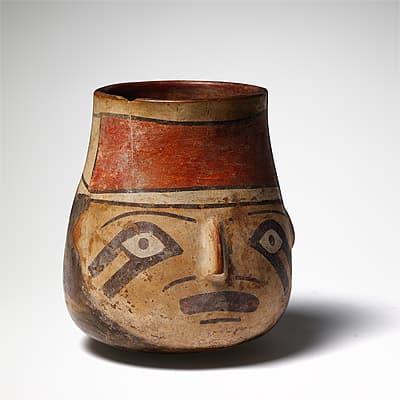
NAZCA culture South coast 100 – 700 AD
Beaker [Painted beaker depicting a human face with the nose in relief] c.140 AD ceramic13.0 (h) cm 11.8 cm (diameter) National Gallery of Australia, Canberra NGA 1982.2061 Purchased 1982
Vessels such as this beaker undoubtedly had a ceremonial function, as they were made to contain liquids such as chicha, blood or water. They also served as grave goods, to accompany a dead person on his mysterious journey. The beakers had rounded bases, to be set into sand and then easily tipped to pour. The motif, of a head with simple headdress, may represent a trophy head, with the common Nazca iconography of black eye-marking in the form of a falcon or hawk. The nose stands out in high relief from the otherwise globular form of the beaker.
The ceramic has been dated to c. 140 AD by thermoluminescence testing of a small sample from a hidden surface, to establish the approximate time in which the beaker was originally created.1 The result places it firmly within the Early Nazca period, to which it belongs stylistically.
Christine Dixon
1. The vessel was tested at the Australian National University, Canberra, on
16 September 1981, with a result of 1840 years BP = 141 CE, NGA file 73/3775, folio 65 test 439, no. S159.
Vessels such as this beaker undoubtedly had a ceremonial function, as they were made to contain liquids such as chicha, blood or water. They also served as grave goods, to accompany a dead person on his mysterious journey. The beakers had rounded bases, to be set into sand and then easily tipped to pour. The motif, of a head with simple headdress, may represent a trophy head, with the common Nazca iconography of black eye-marking in the form of a falcon or hawk. The nose stands out in high relief from the otherwise globular form of the beaker.
The ceramic has been dated to c. 140 AD by thermoluminescence testing of a small sample from a hidden surface, to establish the approximate time in which the beaker was originally created.1 The result places it firmly within the Early Nazca period, to which it belongs stylistically.
Christine Dixon
1. The vessel was tested at the Australian National University, Canberra, on
16 September 1981, with a result of 1840 years BP = 141 CE, NGA file 73/3775, folio 65 test 439, no. S159.
Vessels such as this beaker undoubtedly had a ceremonial function, as they were made to contain liquids such as chicha, blood or water. They also served as grave goods, to accompany a dead person on his mysterious journey. The beakers had rounded bases, to be set into sand and then easily tipped to pour. The motif, of a head with simple headdress, may represent a trophy head, with the common Nazca iconography of black eye-marking in the form of a falcon or hawk. The nose stands out in high relief from the otherwise globular form of the beaker.
The ceramic has been dated to c. 140 AD by thermoluminescence testing of a small sample from a hidden surface, to establish the approximate time in which the beaker was originally created.1 The result places it firmly within the Early Nazca period, to which it belongs stylistically.
Christine Dixon
1. The vessel was tested at the Australian National University, Canberra, on
16 September 1981, with a result of 1840 years BP = 141 CE, NGA file 73/3775, folio 65 test 439, no. S159.

